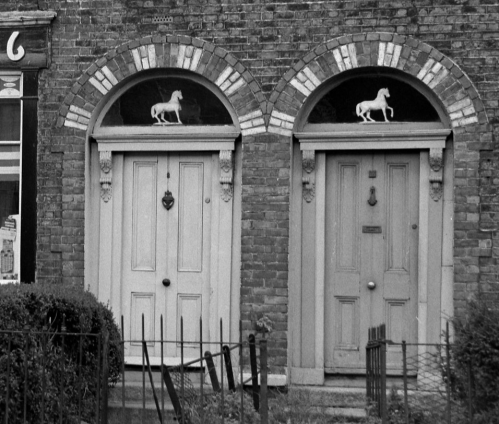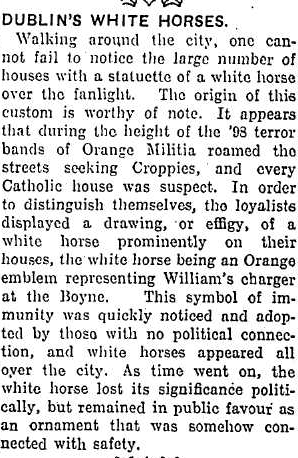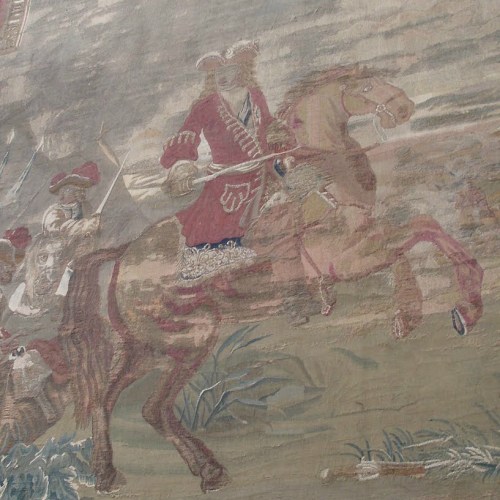
Upper Grand Canal Street, 1967 (National Library of Ireland)
Having spent a lot of time in recent months in Belfast, I became accustomed to the iconography that celebrates King William III’s victory at the Battle of the Boyne. Billy on the walls is always depicted upon a white horse. Perhaps Benjamin West’s iconic 1778 painting, The Battle of the Boyne, has been most important in establishing this in popular memory, though some historians have disputed the claim. Regardless of what colour the horse at the Boyne was, the fact of history is that William was victorious (with Papal blessing no less), and Seamus a’ chaca (“James the shit”, as the defeated King James II was derisively known in Ireland) has a bad day out in a field in Louth.
Images of white horses adorn Orange Order banners, murals, commemorative tea towels and everything one can imagine. More forgotten is the fact they were once a frequent sight in the fanlights of Dublin houses. There is dispute over just what the white horses once fashionable in parts of Dublin meant, but many suggest they denoted a Protestant home and identity.
In 1934, a writer to The Irish Press insisted that “away back in the days when Orangeism was rampant in Dublin, houses which displayed the white horse of Hanover in their fanlights were left unmolested”, something also mentioned in a piece from the Evening Herald around the same time, suggesting that “during the height of the 1798 terror, bands of Orange Militia roamed the streets seeking Croppies, and every Catholic house was suspect. In order to distinguish themselves, the loyalists displayed a drawing, or effigy, of a white horse prominently on their houses, the white horse being an Orange emblem representing William’s charger at the Boyne.”

Evening Herald, February 1937.
Other accounts suggest that the primary reason to display such a symbol was to make a polite but clear point towards those carrying out Catholic church collections or other such door to door activities. One 1930s source claims that “these ornaments are most numerous in the neighborhood of Prussia Street.”
Whatever they once meant, as time went on these symbols lost their political significance of course (if they ever had any to some who displayed them). Within the collections of the National Folklore Collection, housed in University College Dublin, some inner-city Dublin Protestants tell of “displaying statues of white horses that, to their eyes, represented William of Orange, while to onlookers they appeared to be merely decorative items (thus allowing them to display important iconography after Independence without exposing them to problems with their Catholic neighbours.”
The diversity of Protestant identity in Dublin should never be forgotten too, something beautifully captured in the autobiographies of Sean O’Casey. A few white horses survive in Dublin today, while during regular banking hours one can walk into the House of Lords in the Bank of Ireland College Green and see the eighteenth century tapestry displayed there, depicting Billy’s victory on the Boyne. Note the horse:

Tapestry in the House of Lords, Bank of Ireland.

 Click on the book for more.
Click on the book for more. Click on the book for more.
Click on the book for more.
King Billy’s gloves which he wore at the Battle of the Boyne are on the display in the museum at Collins’s Barracks. A great article-thank you very much.
There’s still a few about about I saw one in Trim a year or two ago, and one in Dublin about 5 years ago.
Hi, very interesting piece. I’m not going to dispute the white horse of William III, it clearly is. I just want to note that in the context of 1798, when the ruling monarch was George III of the House of Hanover, the white horse would have been doubly significant as a symbol of loyalty, as it was a heraldic symbol of the ruling dynasty. The loyalist Rathfarnham yeoman cavalry had the white horse on its flags in 1798, and according Hayes McCoy’s book A History of Irish Flags from the Earliest Times that flag can be found in the National Museum’s collection
Often wondered what the reason was for the popularity of the white Hanover horse was in Dublin. Now I know. John J Cronin’s comment on the heraldry of the House of Hanover is of particular interest.
I know two houses in Galway with the white horse in the fanlight… I always thought them cute…and hey now I know a logical reason for iot…but of course don’t know if the particular houses here were of the Protestant faith…I wouldn’t have thought so…that said, they may have been following fashion…not too many fanlights in the West…interesting piece…thanks Brian
[…] Swim, and we remembered the Pike Theatre, a lost (and tiny) Dublin institution. We had migrantion, white horses and censorship in there […]
To this day, there is a white horse in the fanlight of a house at Erne Street Upper off Pearse Street which has been displayed for decades. I tend to believe that it represents the tradition of Protestant Ascendancy.